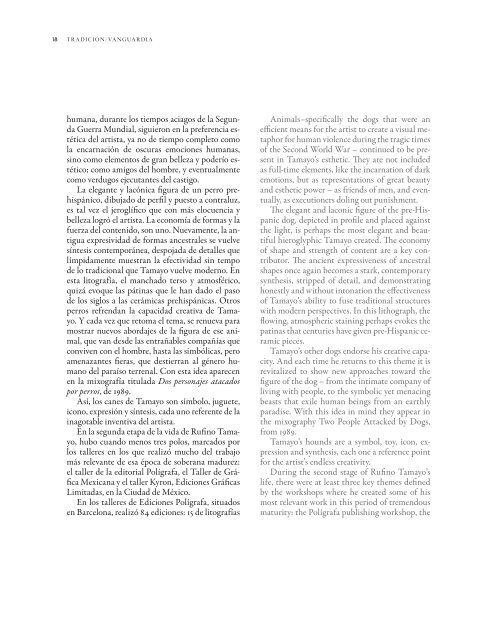TAMAYO - TRADICIÓN:VANGUARDIA
Create successful ePaper yourself
Turn your PDF publications into a flip-book with our unique Google optimized e-Paper software.
18<br />
TRADICIÓN/<strong>VANGUARDIA</strong><br />
humana, durante los tiempos aciagos de la Segunda<br />
Guerra Mundial, siguieron en la preferencia estética<br />
del artista, ya no de tiempo completo como<br />
la encarnación de oscuras emociones humanas,<br />
sino como elementos de gran belleza y poderío estético;<br />
como amigos del hombre, y eventualmente<br />
como verdugos ejecutantes del castigo.<br />
La elegante y lacónica figura de un perro prehispánico,<br />
dibujado de perfil y puesto a contraluz,<br />
es tal vez el jeroglífico que con más elocuencia y<br />
belleza logró el artista. La economía de formas y la<br />
fuerza del contenido, son uno. Nuevamente, la antigua<br />
expresividad de formas ancestrales se vuelve<br />
síntesis contemporánea, despojada de detalles que<br />
límpidamente muestran la efectividad sin tempo<br />
de lo tradicional que Tamayo vuelve moderno. En<br />
esta litografía, el manchado terso y atmosférico,<br />
quizá evoque las pátinas que le han dado el paso<br />
de los siglos a las cerámicas prehispánicas. Otros<br />
perros refrendan la capacidad creativa de Tamayo.<br />
Y cada vez que retoma el tema, se renueva para<br />
mostrar nuevos abordajes de la figura de ese animal,<br />
que van desde las entrañables compañías que<br />
conviven con el hombre, hasta las simbólicas, pero<br />
amenazantes fieras, que destierran al género humano<br />
del paraíso terrenal. Con esta idea aparecen<br />
en la mixografía titulada Dos personajes atacados<br />
por perros, de 1989.<br />
Así, los canes de Tamayo son símbolo, juguete,<br />
icono, expresión y síntesis, cada uno referente de la<br />
inagotable inventiva del artista.<br />
En la segunda etapa de la vida de Rufino Tamayo,<br />
hubo cuando menos tres polos, marcados por<br />
los talleres en los que realizó mucho del trabajo<br />
más relevante de esa época de soberana madurez:<br />
el taller de la editorial Polígrafa, el Taller de Gráfica<br />
Mexicana y el taller Kyron, Ediciones Gráficas<br />
Limitadas, en la Ciudad de México.<br />
En los talleres de Ediciones Polígrafa, situados<br />
en Barcelona, realizó 84 ediciones: 15 de litografías<br />
Animals–specifically the dogs that were an<br />
efficient means for the artist to create a visual metaphor<br />
for human violence during the tragic times<br />
of the Second World War – continued to be present<br />
in Tamayo’s esthetic. They are not included<br />
as full-time elements, like the incarnation of dark<br />
emotions, but as representations of great beauty<br />
and esthetic power – as friends of men, and eventually,<br />
as executioners doling out punishment.<br />
The elegant and laconic figure of the pre-Hispanic<br />
dog, depicted in profile and placed against<br />
the light, is perhaps the most elegant and beautiful<br />
hieroglyphic Tamayo created. The economy<br />
of shape and strength of content are a key contributor.<br />
The ancient expressiveness of ancestral<br />
shapes once again becomes a stark, contemporary<br />
synthesis, stripped of detail, and demonstrating<br />
honestly and without intonation the effectiveness<br />
of Tamayo’s ability to fuse traditional structures<br />
with modern perspectives. In this lithograph, the<br />
flowing, atmospheric staining perhaps evokes the<br />
patinas that centuries have given pre-Hispanic ceramic<br />
pieces.<br />
Tamayo’s other dogs endorse his creative capacity.<br />
And each time he returns to this theme it is<br />
revitalized to show new approaches toward the<br />
figure of the dog – from the intimate company of<br />
living with people, to the symbolic yet menacing<br />
beasts that exile human beings from an earthly<br />
paradise. With this idea in mind they appear in<br />
the mixography Two People Attacked by Dogs,<br />
from 1989.<br />
Tamayo’s hounds are a symbol, toy, icon, expression<br />
and synthesis, each one a reference point<br />
for the artist’s endless creativity.<br />
During the second stage of Rufino Tamayo’s<br />
life, there were at least three key themes defined<br />
by the workshops where he created some of his<br />
most relevant work in this period of tremendous<br />
maturity: the Polígrafa publishing workshop, the



